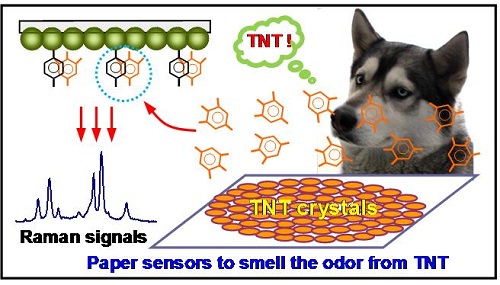Recently, Prof. Zhongping Zhang’s research group in Institute of Intelligent Machines (IIM)
,
Chinese
Academy
of Sciences, has made significant progress in using Raman sensor strips to detect the odors of explosive trinitrotoluene (TNT) crystals and residues in the open environment. A paper entitled “Inkjet-Printed Silver Nanoparticle Paper Detects Airborne Species from Crystalline Explosives and Their Ultratrace Residues in Open Environment” was published on Analytical Chemistry (Anal. Chem. 2014, 86, 3338−3345.).
In this paper, the researchers inkjet printed silver nanoparticles (AgNPs) on cellulose paper and established a Raman spectroscopic approach to detect the odors of explosive trinitrotoluene (TNT) crystals and residues in the open environment. The layer-by-layer printed AgNP paper was modified with p-aminobenzenethiol (PABT) for efficiently collecting airborne TNT via a charge-transfer reaction and for greatly enhancing the Raman scattering of PABT by multiple spectral resonances. Thus, a Raman switch concept by the Raman readout of PABT for the detection of TNT was proposed. The AgNPs paper at different sites exhibited a highly uniform sensitivity to TNT due to the layer-by-layer printing, and the sensitive limit could reach 1.6 × 10−
17 g
/cm2 TNT. Experimentally, upon applying a beam of near-infrared low-energy laser to slightly heat (but not destruct) TNT crystals, the resulting airborne TNT in the open environment was probed at the height of
5 cm
, in which the concentration of airborne species was lower than 10 ppt by a theoretical analysis. Similarly, the odors from 1.4 ppm TNT in soil and 7.2, 2.9, and 5.7 ng/cm2 TNT on clothing, leather, and envelope, respectively, were also quickly sensed for 2 s without destroying these inspected objects.

Paper link: http://pubs.acs.org/doi/abs/10.1021/ac403409q
|